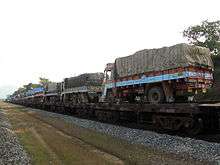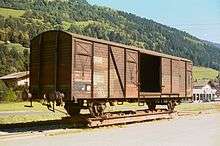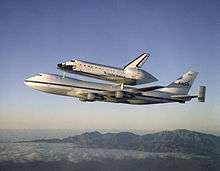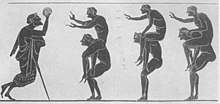Piggyback (transportation)
Piggyback transportation refers to the transportation of goods where one transportation unit is carried on the back of something else. It is a specialised form of intermodal transportation and combined transport.[1]
.jpg)
Etymology
Piggyback is a corruption of pickaback, which is likely a folk etymology alteration of pick pack (1560s), which perhaps is from pick, a dialectal variant of the verb pitch.[2]
Examples
Rail
_(6265367138).jpg)

In rail transport, the practice of carrying trailers or semi-trailers in a train atop a flatcar is referred to as "piggybacking".[3] Early drawings of the Liverpool & Manchester Railway c1830 show road coaches being piggybacked on railway flat wagons.[4]
The rail service provided for trucks which are carried on trains for part of their journey is referred to as a rolling road, or rolling highway. A related transportation method is the rail transport of semi-trailers, without road tractors, sometimes referred to as "trailer on flatcar" (TOFC).
It is also possible to carry a railway wagon of one track gauge on a flat railway wagon (transporter wagon or rollbock) of another gauge. Whole trains of one gauge can be carried on a train of flat wagons of another gauge, as was done in by the Commonwealth Railways on the Marree railway line in Australia between Telford Cut and Port Augusta in the 1950s.[5][6]
The loading of semi-trailers in the United States grew from 1% of freight in 1957 to 5% in 1964 and 15% in 1986.[7][8]
Marine
Small ships of all kinds can be piggybacked on larger ships. Examples include lifeboats, landing craft, and minesweepers on motherships,[9] as well as Midget submarines on larger submarines, such as those used for the 1942 Japanese submarine attack on Sydney.
Air transport
The 1930s British Short Mayo Composite, in which a smaller, four-engine floatplane aircraft named Mercury was carried aloft on the back of a larger four-engine flying boat named Maia, enabled the Mercury to achieve a greater range than would have been possible had it taken off under its own power. The American Space Shuttle was carried on top of specially-modified Boeing 747 Shuttle Carrier Aircraft when the shuttle landed at places other than Kennedy Space Center.
Space
In space transportation systems, a smaller satellite that is carried as a secondary payload on a launch is said to be "piggybacked" on the main launch. It is often the case of small satellites and cubesats, since they can not usually afford accessing space on a dedicated launch and they choose instead to take profit of the remaining payload capacity in a big satellite launch. However, this is usually at the cost of not being able to fly to their desired orbit and having to remain on a similar orbit to that of the big satellite.
Military
The metal caterpillar treads of a tank wear out quickly when travelling long distances on ordinary roads. Also, tracked vehicles seriously damage the tarmac layer of ordinary roads (unless the caterpillar treads are specially fitted with rubber pads to avoid this). It is therefore necessary to provide tank transporters, which have rubber tires, to the battlefield.
Human locomotion
A person carrying someone else on their back is most commonly seen in the modern day in the form of a parent carrying a child. It may also feature in the context of play or sport, and evidence of this dates back to Ancient Greece where games involving piggyback riding were combined with the requirement of catching or throwing a ball.[10]
Gallery

- Timber wagon on rollbocks


.jpg) Short Mayo Composite just before the first trans-Atlantic flight, August 1938
Short Mayo Composite just before the first trans-Atlantic flight, August 1938 Youths playing a ball game, circa 500 B.C.
Youths playing a ball game, circa 500 B.C. A man killed by a woman when carrying her piggyback in the river.
A man killed by a woman when carrying her piggyback in the river.
See also
References
- Pearlman, Robert Z. (7 September 2012). "Shuttle Endeavour to get one last piggyback ride across US". NBC News. Retrieved 24 October 2012.
- Harper, Douglas. "piggyback". Online Etymology Dictionary. Retrieved 24 October 2012.
- "The Geography of Transport Systems". Archived from the original on 24 March 2012. Retrieved 11 July 2011.
- "The Train Book" by DK, p23
- Pick-a-back operation solves gauge-break problem Adelaide Advertiser
- Complete Narrow-Gauge Trains on Standard-Gauge Wagons Railway Gazette September 9, 1955 pages 305-308
- Piggback: The Trailer Train story Railway Age May 25, 1964 page 44
- Field, Alexander J (2011). A Great Leap Forward: 1930s Depression and U.S. Economic Growth. New Haven, London: Yale University Press. p. 114. ISBN 978-0-300-15109-1.
- "Mine-Sweepers By "Piggyback"", The Mercury (Hobart): 5, 5 June 1951
- Gardiner, E. Norman, 'Athletics of the Ancient World', Oxford: OUP, 1967, illustration 209 / facing p. 230
External links
| Look up piggyback in Wiktionary, the free dictionary. |
| Wikimedia Commons has media related to Piggy-back transport. |